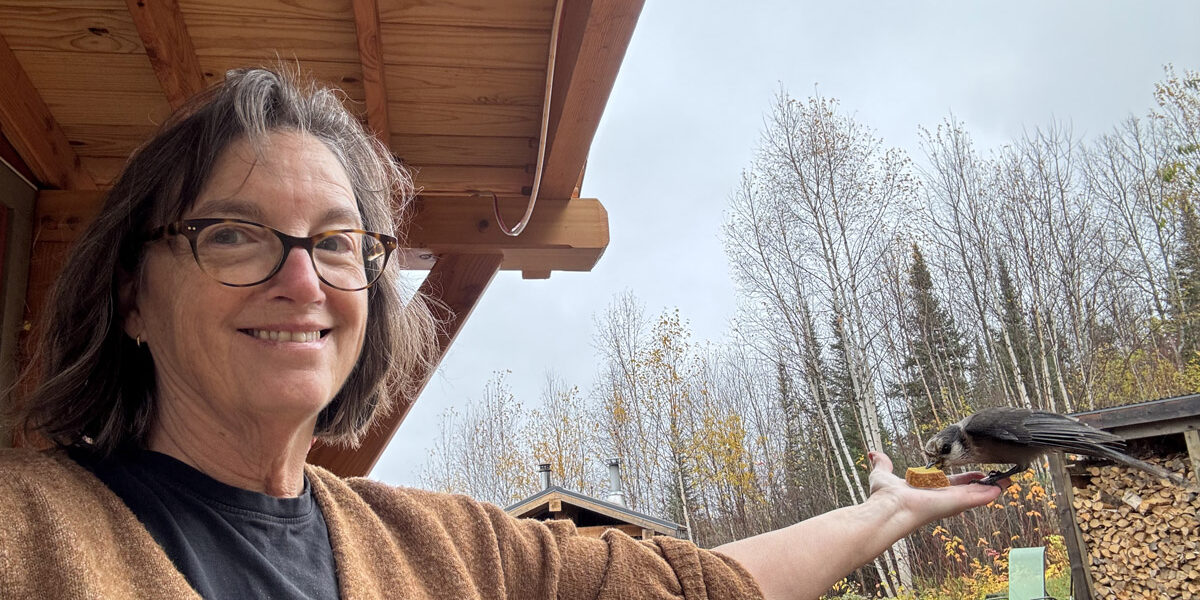Trail Time – The Art of Noticing
I’ve been doing this little spot on WTIP for over four years now and the process of writing about what happens on the Gunflint Trail has made me continually practice one of my favorite games: The Art of Noticing. The practice helps me hold images and impressions in my mind so I can share them later, hopefully giving people the feel of the Trail experience even if they can’t be here.
At summer’s end I thought of my favorite paddle this year, on a flat river where the the grass laid down in the direction of the current, looking like bright green spears lying on a black mirror surface. Turtles plopped into the water, pitcher plants caught insects with their secret sticky traps. This is an image to cherish all winter long.
This week I’m noticing:
The pinch in my fingers from the cold morning temps
The brisk step needed to stay warm on my walks
The moose prints in the mud
The young willow with every thin branch nipped by the moose’s teeth
The wolf scat full of hair on the path
The shortness of the day
The Canada jays are back now and I spent a delightful few minutes this morning getting them to feed out of my hand. That never gets old! It was rainy today so every time the three birds returned they looked a little more bedraggled from flying through the wet woods to stash their food. They chirp when they approach and as they grab the food from my hand and as they fly away. They are very vocal birds, but these are soft contact sounds. I love the way they float down to a landing. Gray Jays are corvids, in the same family as ravens, so they are smart and store food for later use.
I love birds — they are such good company in winter — so we have long strings hanging on our windows to prevent bird strikes. Nevertheless, a few birds die each year smashing into our windows. Some are just stunned and take a few moments to recover before they fly off. Two young vireos collided last summer and sat on the side of the raised garden for a few minutes, their mouths open wide. I tentatively walked toward them and then they were gone in a flurry of wings.
I killed two birds on the way to town yesterday. The little songbirds that feed on the gravel in the road don’t stand a chance against a car going 50 miles an hour. Last summer a hawk dove right in front of my car and took out the towing hook cover on its way to its demise. I watched the hawk descend, wings stretching back, laser-focused on some mouse or vole or something on the road. A few winters ago a fox died under my woodshed and shortly after that, so did a pie-billed grebe. That was the same winter there was a moose-car collision on the Trail not far from my road. The evidence on the side of the road was gruesome. Death is everywhere in the northwoods and we don’t talk about it much. But fall is here, leaves are falling off trees, nights are getting longer and the spooky hour approaches.
The scary season is nigh upon us. I’m not only talking about Halloween, I’m talking about all the things that need to get done to prepare for winter. Necessary work that goes unfinished scares me more than ghosts. Like all the other beings in the woods, we need to prepare for a long cold spell. Some of us move south, like most of the birds do. Some of us hole up like beavers, and need to prepare our lodge and store up food for when the weather gets bad. Some of us hibernate. Some of us like to winter camp, so we make our temporary homes in the snow like the grouse do when they need shelter. Most of the mammals who call the north their home don’t have permanent homes, but will use whatever is necessary when it is time to bear their young.
We bipeds expand our range so have outdoor work beyond our shelters too. There’s freed to be split (there’s always firewood to be split). The snowblower has to be serviced, the sprinkler system has to be unhooked and drained, ready for next year’s fire season. All the outdoor furniture has to be moved so we don’t run into things hidden under the snow. And in order for the cabin not to be overgrown in the spring, there’s brush cutting to be done. Don’t worry, everything up here grows to fill any hole that I make. In fact, shrubs like willow, dogwood, hazel, moose maple and alder LOVE to be cut. It reinvigorates them and the new shoots come back with gusto in the spring. These are, in fact, browse plants for moose. They have evolved together in a mutually beneficial way, much like Lars and I have, up here on the Gunflint Trail.
— Marcia Roepke











